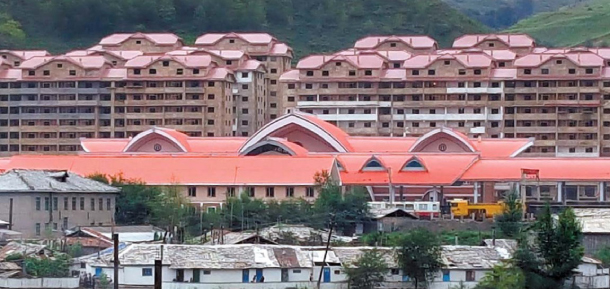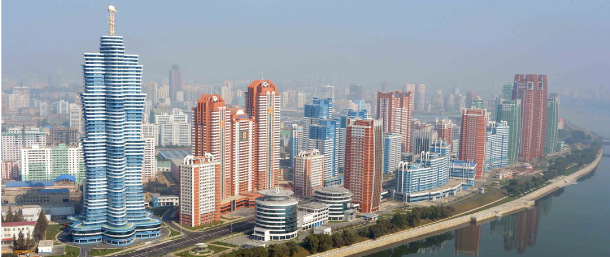How private trade is transforming the North
To commemorate the 53rd anniversary of its founding, the JoongAng Ilbo is running a special series of reports on the development of a market economy in North Korea. The JoongAng Ilbo teamed up with the Institute for National Security Strategy (INSS), a national security research institute under the National Intelligence Service, to interview recent defectors on the current state of North Korea’s economy. Interviewees ranged across economic classes and geographical areas. They included some higher level defectors with knowledge of the regime’s economic policies and how they are changing. Names have been withheld or changed for the defectors’ security and that of their families still living in the North. - Ed.
New high rises loom over a recently remodeled train station on Sept. 28 in the city of Hyesan, the capital of North Korea’s Ryanggang Province, where a lot of commerce takes place across the border with China. Many people who live in regular houses dream of making enough money in trading to move into new apartments. [PARK JONG-CHOL]
Operating a small stall in the corner of the Hyesan market - one of the roughly 430 licensed jangmadang, or private marketplaces, across North Korea - Hyeson earned around 500 Chinese yuan ($72) every month. Many transactions in such markets are in foreign currencies, especially the yuan. She sold Chinese-made tennis shoes, which are in high demand in North Korea. Her supplier was a relative of her husband who lives across the border in China. She made her orders via cellphone.
In the mornings, licensed vendors like Hyeson gathered for mandatory ideological reeducation sessions - a kind of tradeoff by the government in exchange for permitting private enterprise in the afternoons. As long as Hyeson paid the 1,500 North Korean won ($1.60) monthly tax to state officials overseeing the market, she was allowed to make enough of a living to feed her four family members - and have money left over to send to relatives in other parts of the country.
The regime’s allowing of such private markets like Hyesan’s was by no means a voluntary development. In the early 1990s, Pyongyang found itself reeling from the effects of the collapse of the communist economic bloc and the subsequent evaporation of all energy imports and economic aid.
In this precarious state, a series of floods and droughts from 1994 to 1998 devastated the country’s agricultural production and reserves, producing a famine that killed over a million people. It is considered one of the greatest humanitarian disasters of the end of the 20th century.
The resulting breakdown of the public distribution system - the crux of North Korea’s planned economy, which was supposed to supply all food and basic necessities to the people - left the populace to fend for itself. North Koreans started relying on black markets for survival.
Aware that prolonged food shortages would endanger its legitimacy to govern, the Kim dynasty allowed the existence of the private markets, but at times attempted to rein them in. The state officially sanctions more than 430 markets nationwide, according to a study by the CSIS in August, in which vendors pay tax to the government for their activities.
The public distribution system, while still extant, is a shadow of its former self, capable of supplying only government workers and laborers in state-owned enterprises with basic necessities. According to a high-level defector with internal knowledge of the country’s food situation, the state currently distributes food to only a third of its population - around 7.8 million people - while leaving the rest to fend for themselves.
Another defector broke down the specifics.
“The 8 million farmers and agricultural workers survive on the yields of their farms, while average industrial workers also subsist on their own,” he said. “But in Pyongyang and among laborers who work in normally functioning factories, food security is guaranteed.”
The burden of public distribution, analysts say, was reduced further after an amendment to the “socialist responsible management system to enterprises” in 2014, in which the management of production, employment and quality control, as well as the development of new products, was almost entirely made the job of managers in state-run enterprises.
“The North Korean regime knows that if it does away with the market, its people will starve,” said Lim Soo-ho, senior research fellow at the INSS. “It is reducing the state’s burden by allowing its people to take care of sustenance needs through the jangmadang, and instead investing its surplus energy on strategic industries.”

Colorful apartment buildings dot the Mirae Scientists Street, a newly developed area on the banks of the Taedong River in Pyongyang, which was officially inaugurated in November 2015. [KCNA/YONHAP]
Proof of this growth is an ever increasing variety of jobs and businesses that have sprouted up, resembling those available in market economies across the world.
North Koreans now buy large consumer appliances like refrigerators at a special store. Money changers walk around the informal markets asking people if they need to exchange North Korean won for Chinese yuan, Euros or American dollars. There are specialized courier services that move merchandise around. Private day care centers have opened up to take care of children of working mothers. Retired teachers now offer their knowledge in private lessons to those who can afford it.
But perhaps nowhere is the country’s rapid move towards marketization more apparent than in real estate - also one of the most ostensible signals of the growth of internal moneyed interests.
Even in smaller regional cities like Hyesan, where the shoe vendor Hyeson dreamed of moving into a new apartment, a building boom is underway to house the growing moneyed classes of its budding market economy.
In the capital of Pyongyang, real estate transactions are now a commonplace phenomenon among the elite and well-to-do.
Myongji University Professor Yoo Hong-jun says Pyongyang has been transformed from the gray monotony he saw on a visit there over a decade ago. On a recent visit as a member of the entourage accompanying South Korean President Moon Jae-in to the inter-Korean summit last month, Yoo said the North’s capital was filled with new skyscrapers and colorful buildings. Since taking power in 2011 following his father’s death, leader Kim Jong-un has paid particular attention to sprucing up the capital city, undertaking major construction projects to trumpet the regime’s focus on economic growth under his rule.
Ryomyong Street, a shiny new commercial district anchored by the Kumsusan Palace of the Sun - a mausoleum where Kim Il Sung and his son Kim Jong-il are laid in state - and the Mirae Scientists Street on the banks of the Taedong River are the signature landmarks of Kim’s drive: bright modern facades in an otherwise gray and antiquated city.
On Ryomong Street, 44 new apartment buildings - including one with 70 floors - capable of housing around 4,800 families were newly built along with parks, restaurants and a polished shopping mall, which opened on the 105th anniversary of founder Kim Il Sung’s birthday.
Tae Yong-ho, who was North Korea’s former deputy ambassador to the United Kingdom before defecting in 2016, told Yonhap News last year that the street was built and inaugurated at a breakneck pace in order to prove to the world that international sanctions were incapable of crippling the North’s economy.
Mirae Scientists Street is known for colorful high rises rewarded to scientists and engineers who participated in the country’s successful nuclear development in recent years. The area mirrors Changgwang Street, today one of Pyongyang’s most vibrant commercial districts, which was remodeled in 1980 by former leader Kim Jong-il to reward artists and performers who aided the propaganda efforts that legitimized his succession from his father Kim Il Sung.
While those projects were spearheaded by the state and the apartments distributed on the basis of loyalty to the regime, private sales are driving the real estate at large.
Technically, buying and selling housing units are not only illegal but impossible, given that North Korea’s socialist system does not allow individuals to own land or residential property. The state gives citizens rights over the units, which over time has come to mean de facto ownership.
Real estate transactions take the form of trading those rights, a practice that has steadily become conventional in most of the country’s major cities from the capital Pyongyang to regional centers like Nampo, Kaesong, Chongjin, Sinuiju or Rason.
In the North, demand is greatest for the first to tenth floors of apartments, as opposed to South Korea, where the priciest units are situated on the higher floors sporting the best views. This is because North Korea’s unstable energy situation leads to frequent blackouts, during which residents cannot use elevators and must take the stairs. Lower floors therefore are more convenient.
A variety of residences are traded on the market, ranging from single-floor houses to apartment units, with price tags that fluctuate according to demand. According to a Radio Free Asia report from July, the median price for an apartment in Pyongyang stands at around 5,000 to 8,000 Chinese yuan per square meter (10.7 square feet). A similar home in Sinuiju, a city in the northwest that borders China, costs a similarly high rate of around 5,000 yuan per square meter due to the vibrant economic activity that takes place on the border.
The most expensive property in Pyongyang, a number of defectors who lived there unanimously agreed, were units in a 36-story high rise building near Pyongyang Station. Living rights for a 200 square meter apartment in that building cost around $200,000, they said.
Meanwhile, growing demand for such transactions have given birth to a new career path: realtor.
Of course, the fact that all occupations are determined and registered by the state makes this an informal rather than actual job, and these brokers conduct businesses under the government’s radar. They can’t set up an office, said one defector who lived in Pyongyang, so their business is mainly done through cellphones and person-to-person transactions.
“In the past, when you were looking to find new housing, there were people who helped you find it as a favor,” he said. “Now there are people who do this as a real job.”
This new class of realtors finds available housing options according to customers’ preferences, haggle with sellers, and also take care of the paperwork that comes with registering residential transfers with the local administrative office. They are usually paid around $500 to $1,000 per transaction, defectors say.
As in South Korea, where real estate is considered a fine investment, North Koreans with capital at their disposal are increasingly turning towards real estate, defectors say.
One defector who used to live in Pyongyang says a 40-pyeong (around 132 sq. meters) sized apartment in central Pyongyang that used to cost $25,000 in 2003, has now jumped in price to around $200,000.
He added that many North Koreans rely on remittances sent by relatives living abroad - often in China - or money they themselves saved while working abroad as base capital for such investments.
The types of housing transactions have also become more varied. Defectors brought up cases in which people have leased out their homes and pull in a monthly or yearly rent rather than trading residences outright. In some cases, people lease out their homes and then live in another leased home to live off the rent they receive.
One defector who used to live in Sinuiju recalled a case in which a family rented out part of their house - the kitchen - to a tenant and resided in the living room. “The monthly rent they receive from an arrangement like this ranges from 50 to 100 North Korean won,” he said.
BY JEONG YONG-SOO, KWEN YU-JIN, KIM JI-A and SHIM KYU-SEOK [shim.kyuseok@joongang.co.kr]










with the Korea JoongAng Daily
To write comments, please log in to one of the accounts.
Standards Board Policy (0/250자)